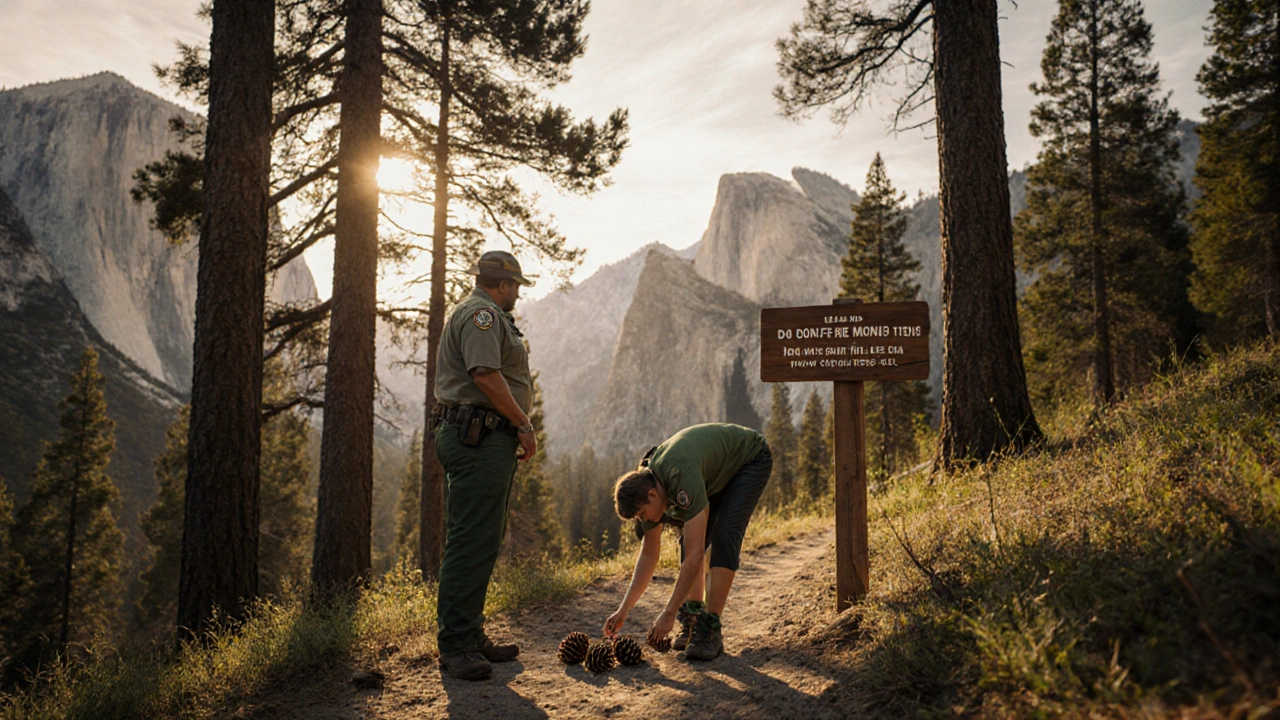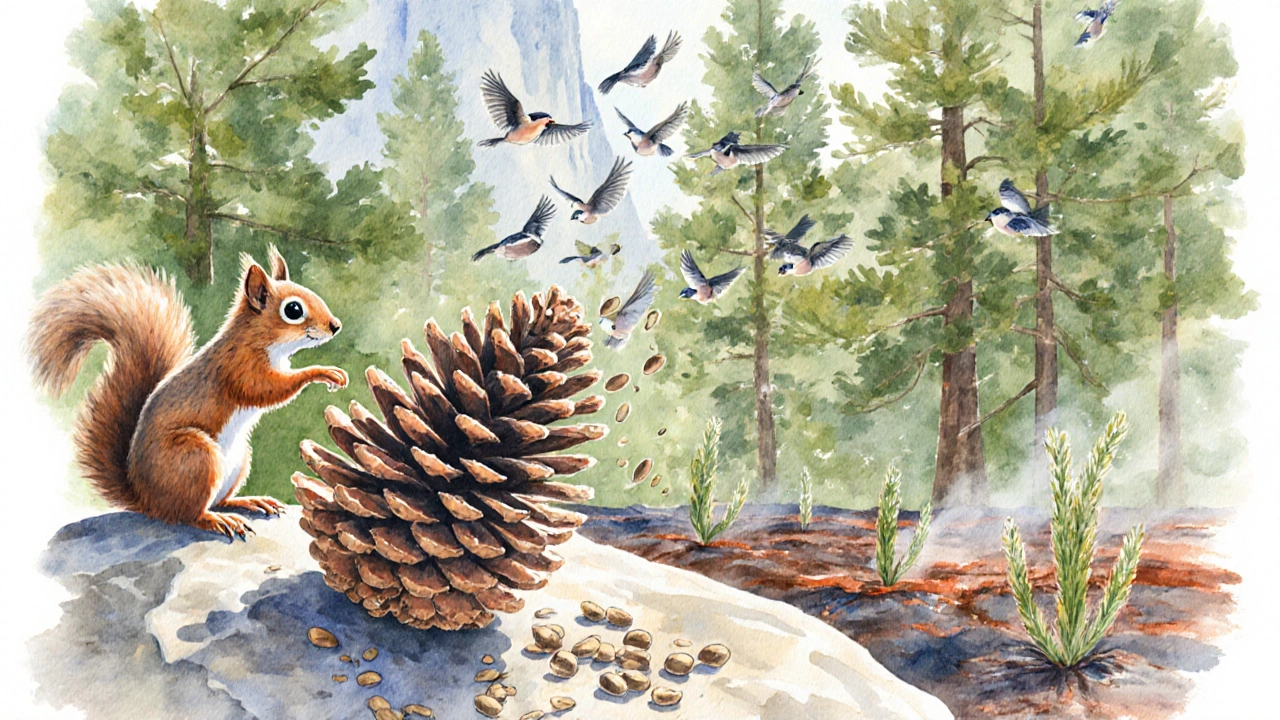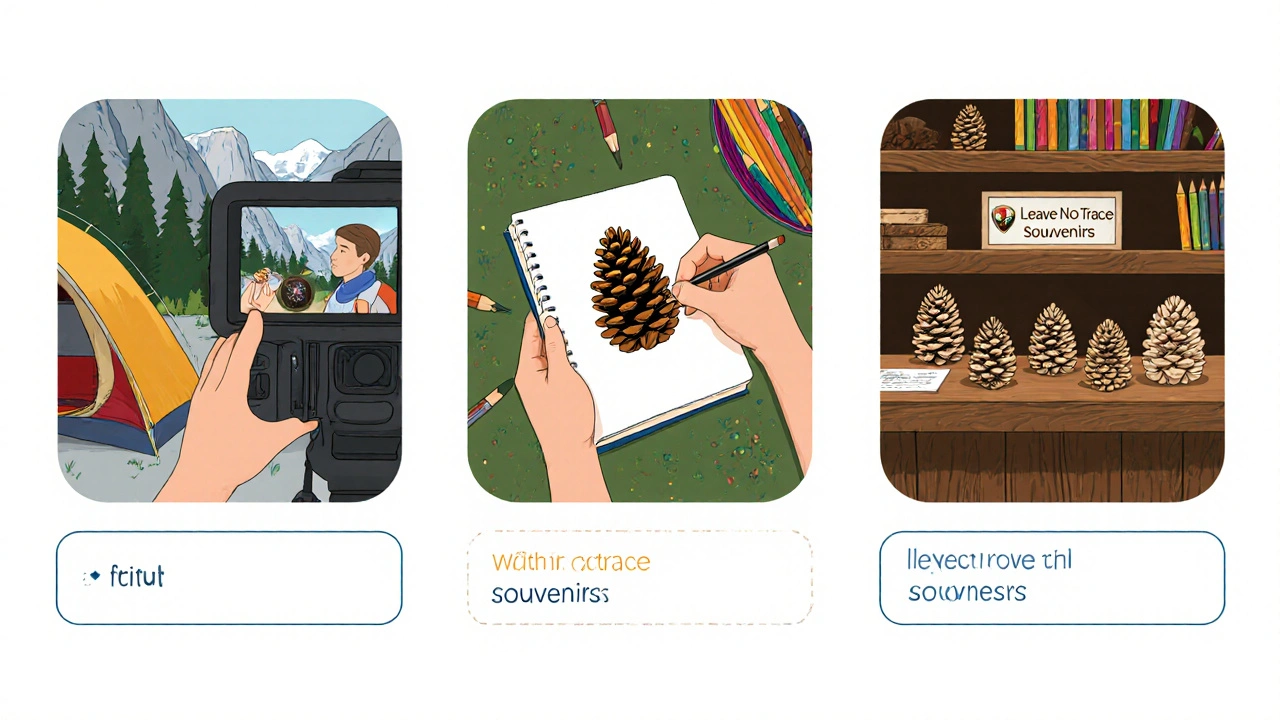Can You Collect Pine Cones in Yosemite National Park? Rules, Tips & Alternatives

Yosemite Pine Cone Compliance Checker
Determine if your intended action complies with Yosemite National Park regulations. Remember: collecting pine cones is generally prohibited to protect the ecosystem.
Ever picked up a pine cone on a hike and wondered if you could bring it home as a souvenir? In Yosemite National Park the answer isn’t as simple as “yes” or “no.” This guide breaks down the exact rules, why they exist, and how you can enjoy the park without breaking the law.
What Yosemite National Park Says About Taking Natural Items
Yosemite National Park is a protected federal wilderness area managed by the U.S. National Park Service (NPS) in California’s Sierra Nevada. The park’s mission is to preserve its natural and cultural resources for future generations. Because of that mission, the NPS has a clear policy: you may not remove any natural or cultural artifacts, including rocks, plants, and pine cones the reproductive structures of pine trees that fall to the forest floor each autumn, without a special permit.
The rule is listed in the official Yosemite visitation guidelines and reinforced in every ranger talk and interpretive sign throughout the park.
Why Pine Cones Matter to the Ecosystem
Pine cones are more than decorative trinkets; they play a vital role in the life cycle of the park’s iconic pine species, such as the Jeffrey pine (Pinus jeffreyi) and the ponderosa pine (Pinus ponderosa). The cones contain seeds that feed wildlife-from squirrels to birds-and help re‑seed the forest after fires. Removing them in large numbers can reduce seed banks and slow natural regeneration.
Additionally, the park’s high visitor numbers already put pressure on fragile habitats. By leaving pine cones where they fall, you help maintain the balance that park ecologists have spent decades monitoring.
Specific Regulations You Need to Know
The NPS outlines three main categories of prohibited collection:
- Live plants and associated parts - this includes pine cones, needles, bark, and roots.
- Geological materials - rocks, mineral samples, and sand.
- Cultural artifacts - any items left by indigenous peoples or historic structures.
Violations are considered a federal offense. Penalties can range from a warning to a $250 fine, and in severe cases, prosecution under the 1966 Archaeological Resources Protection Act.
If you need a sample for scientific research, you must apply for a special permit through the NPS Resource Management office-a process that can take weeks and requires a clear justification.
How This Interacts with Yosemite Camping Reservations
Many visitors assume that because they have a campsite reservation, they have broader rights to collect souvenirs. That’s not the case. Whether you’re staying at Upper Pines, North Pines, or a backcountry site, the same collection rules apply. Your reservation only guarantees a sleeping spot; it does not grant permission to remove natural items.
In fact, campgrounds often have reinforced signage reminding guests that “Leave No Trace” applies to everything you bring in or take out. Rangers routinely patrol campsites during sunrise and sunset checks to ensure compliance.

Leave No Trace Principles Applied to Pine Cones
The Leave No Trace a set of outdoor ethics promoting preservation of natural areas program offers straightforward guidance:
- Plan Ahead: Know the park’s rules before you arrive.
- Travel & Camp on Durable Surfaces: Stay on established trails and campsites to avoid trampling seedlings.
- Dispose of Waste Properly: Pack out all trash, food scraps, and anything you might have brought in.
- Leave What You Find: This includes pine cones, rocks, and even fallen branches.
- Minimize Campfire Impact: Use designated fire rings or stove fuel.
- Respect Wildlife: Observe from a distance; never feed or handle animals.
- Be Considerate of Other Visitors: Keep noise low and share the experience.
By following these steps, you guarantee that future hikers will still find pine cones on the forest floor to admire.
What If You Already Have Pine Cones in Your Backpack?
Accidentally picking up a pine cone isn’t a federal crime, but you should still act responsibly:
- Leave it behind: If you’re still within park boundaries, place the cone back where you found it.
- Dispose of it at a trash receptacle: If you’re exiting the park, discard the cone in a trash bin outside the perimeter.
- Donate to a local school or museum: Some educational programs accept natural specimens for study, provided they are sourced legally.
Never attempt to mail pine cones out of state, as that could violate wildlife transport regulations.
Legal Alternatives to Souvenirs
Want a piece of Yosemite to remember your trip? Here are some park‑approved options:
- Photography: Capture close‑ups of pine cones with a macro lens.
- Sketching or journaling: Bring a field notebook to draw the cones you see.
- Purchase “Leave‑No‑Trace” souvenirs: The Yosemite Visitor Center offers replica pine cones made from sustainable wood.
- Collect fallen needles: The NPS permits gathering a small handful (< 10 g) of pine needles for personal use if you ask a ranger, but this is rarely necessary.

Quick Checklist Before You Leave Yosemite
| Task | Done? |
|---|---|
| Reviewed park collection rules | ☐ |
| Packed all natural items (pine cones, rocks, shells) | ☐ |
| Disposed of any accidentally collected items | ☐ |
| Logged photos and sketches in journal | ☐ |
| Checked campsite for stray trash | ☐ |
Comparison: Allowed vs. Prohibited Items in Yosemite
| Category | Allowed | Prohibited |
|---|---|---|
| Plants (including cones) | None without permit | Pine cones, needles, flowers, bark |
| Rocks & Minerals | None | All rocks, sand, minerals |
| Wildlife | Photography, observation | Live animals, feathers, shells |
| Cultural Artifacts | None | Any historic items, petroglyphs |
| Leave‑No‑Trace Supplies | Reusable water bottles, stoves | Single‑use plastics (unless disposed properly) |
Frequently Asked Questions
Can I take a single pine cone as a memento?
No. The park’s policy treats even one pine cone as a natural resource, so removing it is prohibited without a special scientific permit.
What are the penalties for taking pine cones?
Violations can result in a warning, a fine up to $250, or, in extreme cases, prosecution under federal law. Rangers generally issue warnings for first‑time accidental removals.
Do private campgrounds within Yosemite have different rules?
No. All land inside the national park, whether it’s a public campground, a private concession, or backcountry site, follows the same NPS regulations.
Can I collect pine cones for a school project?
Only with a formal research permit. Contact the Yosemite Resource Management office well in advance and provide a detailed project plan.
Is it okay to bring pine cones into my campsite for fire lighting?
No. Using natural material for fire can introduce pests and is against park fire regulations. Use a portable camp stove or firewood purchased at the campground store.
What should I do if I see someone taking pine cones?
Politely remind them of the park rules, or report the activity to a ranger. Most visitors are unaware and will comply when informed.
Are there any exceptions for Indigenous peoples?
Native American tribes have specific cultural rights that are negotiated separately with the NPS. These rights are not applicable to general visitors.
Can I bring pine cones out of the park for a craft project?
No. Exporting natural material without a permit violates both park policy and federal wildlife transport laws.
If you’re planning a Yosemite adventure, the safest way to honor the park is to leave every pine cone where it fell and capture its memory with a photo, a sketch, or a story you’ll tell later. By respecting these simple rules, you help keep Yosemite wild and beautiful for the next hiker.
Oh, absolutely-just snatch a pine cone like you’re buying a candy bar, because who cares about seed banks, right?
In truth, the National Park Service’s policy is unequivocal: removal of any natural material, including a solitary pine cone, constitutes a violation of federal regulations. This is not a whimsical suggestion but a codified rule, designed to preserve the intricate reproductive cycles of the Jeffrey and Ponderosa pines that dominate Yosemite’s high elevations. While you may feel that a single cone is inconsequential, the cumulative effect of countless visitors pilfering seeds can diminish the forest’s resilience, especially after fire events. Moreover, the permitting process for scientific collection is rigorous for a reason-it ensures that only legitimate research alters the ecosystem.